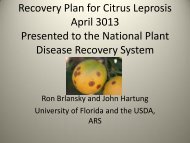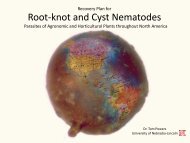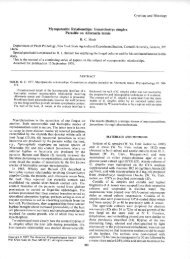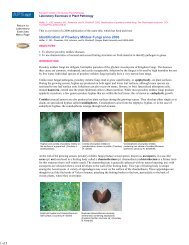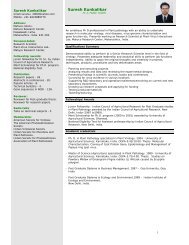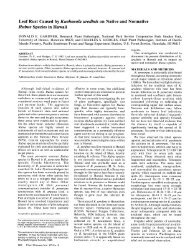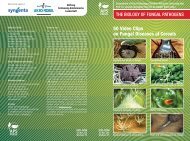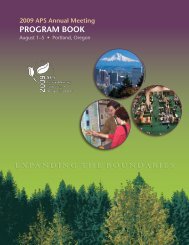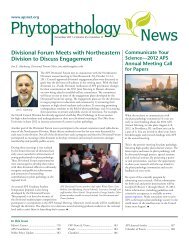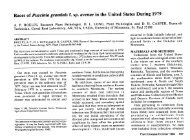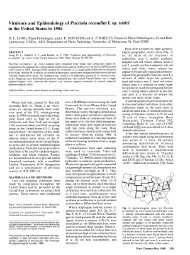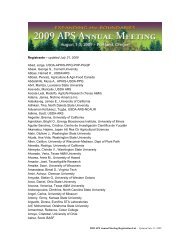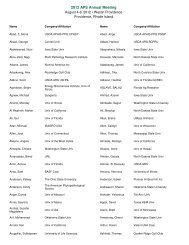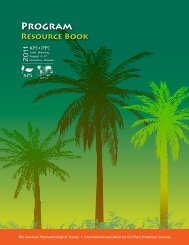view article - American Phytopathological Society
view article - American Phytopathological Society
view article - American Phytopathological Society
Create successful ePaper yourself
Turn your PDF publications into a flip-book with our unique Google optimized e-Paper software.
increased from 0% (Bolinha) and 60% (Corona) after 2 hr of wetness to resistance against two compatible isolates. NIs CL03TTP,<br />
12.5-25% (Bolinha) and 100% (Corona) after8 hr of wetness. Histological C104LAC, C1O1PKT, and C105TTP-4 showed 29-61% fewer lesions than<br />
studies of fruit, in similar stages of development, demonstrated C039. NIs C104PKT and C102PKT differed little from C039. Thus,<br />
morphological differences in the epidermal tissue between resistant certain NIs have residual resistance compared to the recurrent<br />
(Bolinha, Kakamas) and S-genotypes (Corona, UCL)18-8-11). Generally, parent. Efforts are underway to pyramid resistance genes from<br />
R-genotypes had a thicker cuticle, compact epidermal cells, and fewer the NIs showing residual resistance.<br />
trichomes that originated from the first cell layer of the epidermis.<br />
388 392<br />
EVIDENCE FOR CYTOPLASMIC OR MATERNAL DETERMINANTS IN THE<br />
VARIATION IN TOLERANCE TO BENOMYL AMONG COLLETOTRICHUM REACTION OF WHEAT CULTIVARS TO TAN SPOT. Shabeer, A., W. W.<br />
GLOEOSPORIOIDES ISOLATES FROM MANGO. R.T. McMillan, Jr., Bockus, and B. L. Norman, Dept. of Plant Pathology, Kansas State<br />
Michael M. Moss, L.R. Bowling,and L. Stempel, University of Univ., Manhattan, KS 66506.<br />
Florida, IFAS, Trop. Res. & Educ. Center, Homestead, Florida<br />
USA, 33031.<br />
Two tan spot-resistant winter wheat cultivars, Red<br />
and<br />
Chief<br />
Auburn<br />
(RCH)<br />
(ABRN), were crossed with susceptible TAMI05.<br />
In 1987 and 1988 a mango grove located in Dade County Florida Parent and F1 seed of reciprocal crosses was produced in the<br />
USA lost over 50% of the crop to mango anthracnose caused by C.<br />
g1oeosporioides.<br />
greenhouse.<br />
The<br />
Plants<br />
grove<br />
were<br />
was<br />
grown<br />
sprayed<br />
in a randomized<br />
with 1 1/2<br />
block<br />
ibs of<br />
design with<br />
oeosporo ideskly Te gover asd sperayedto4<br />
grehue-lnswr-rw<br />
withk1 1/2er lbsfr<br />
i admzdbokdsg<br />
set 9 replications, 10 plants/entry/replication,<br />
benomyl<br />
inoculated<br />
weekly in flower<br />
with a<br />
and every 3 to 4 weeks after fruit set conidial suspension (1 3 ,000/ml) of Drechslera tritici-repentis,<br />
by the owner in 1987 and by a professional grove management and placed in a mist chamber. The top<br />
company<br />
3 leaves<br />
in 1988,<br />
of each<br />
with<br />
plant<br />
no noticeable control of anthracnose in were rated on a 0-5 scale. Average leaf ratings using<br />
both<br />
ABRN<br />
years.<br />
as<br />
In the summer of 1988, 100 infected fruits were the resistant parent were: ABRN - 0.79,<br />
harvested<br />
ABRN X<br />
randomly<br />
TAM105 (F 1 ) =<br />
from the grove from which 84 single spore 1.80, TAM105 X ABRN (F1 ) 2.18, and TAM105 -<br />
colonies<br />
2.50. Av<br />
were isolated. The isolates were screened at 0, 1, 10, ratings using RCH were: RCH - 0.91, RCH X TAM105 (F 1 ) =<br />
and 100 ppm<br />
2.10,<br />
of benomyl. Out of 84 single spore colonies, nearly TAM105 X RCH (F 1 ) = 2.35, and TAM105 = 2.75.<br />
40%<br />
Ratings<br />
were tolerant<br />
of F<br />
to 10-100 ppm of benomyl, while 1<br />
60% were plants when the resistant parent was used<br />
sensitive,<br />
as a female<br />
showing little or no radial growth. These results significantly (E = 0.05) less than when it was used as ale<br />
may explain the lack of anthracnose control by benomyl in the indicating reciprocal effects.<br />
grove.<br />
389 393<br />
INFECTION OF PEPPER MESOPHYLL PROTOPLASTS WITH PEPPER MILD INDEPENDENT SELECTION OF RESISTANCE TO USTILAGO SCITAMINEA AND<br />
MOTTLE VIRUS USING ELECTROPORATION. J.L. Jacobs and C.T. SUGARCANE MOSAIC VIRUS (SCMV) IN SUGARCANE. M. P. Grisham, B.<br />
Stephens. Michigan State University, East Lansing, MI 48824. L. Legendre, and J. W. Dunckelman, USDA, ARS, Sugarcane Research<br />
Unit, Houma, Louisiana 70361.<br />
Mesophyll protoplasts of pepper (Capsicum annuum) were inoculated<br />
with pepper mild mottle virus (PMMV) by electroporation. Sugarcane<br />
The protoplasts,<br />
smut caused<br />
derived<br />
by Ustilago<br />
from<br />
scitaminea<br />
cotyledons<br />
and<br />
of<br />
sugarcane<br />
seedlings grown mosaic (SCM) caused by SCMV are important<br />
in<br />
diseases<br />
vitro, were<br />
of Louisiana<br />
obtained by treatment with an enzyme solution sugarcane. One-hundred<br />
containing<br />
sugarcane<br />
1.0%<br />
clones<br />
(w/v)<br />
from<br />
Cellulysin,<br />
each of four<br />
0.5% (w/v) Driselase, 0.1% biparental crosses of parents<br />
(w/v) Macerase,<br />
with different<br />
CPW<br />
combinations<br />
salts and 0.4<br />
of<br />
M sorbitol at pH 6.0. reactions<br />
Infection<br />
to U. scitaminea<br />
was<br />
and<br />
achieved<br />
SCMV<br />
with<br />
were evaluated<br />
several direct<br />
for<br />
current pulses resistance t6the two pathogens<br />
of 10<br />
in<br />
msec<br />
separate<br />
at a<br />
field<br />
field<br />
tests.<br />
strength<br />
No<br />
of 0.36 to 0.57 kV/cm and association was found between<br />
a virus concentration<br />
resistance or susceptibility<br />
of 100 pg/ml in<br />
to U.<br />
a 0.7 M mannitol solu- scitaminea and to SCMV<br />
tion.<br />
within<br />
The<br />
or<br />
proportion<br />
among the progeny<br />
of infected<br />
of the<br />
protoplasts<br />
four<br />
was quantified crosses. The<br />
by<br />
breeder<br />
staining<br />
can<br />
with<br />
therefore<br />
viral coat<br />
concurrently<br />
protein-specific<br />
select for<br />
antibodies conju- resistance to U. scitaminea and SCMV, or<br />
gated<br />
independently<br />
to fluorescein<br />
select<br />
isothiocyanate. The percentage of viable for resistance<br />
protoplasts<br />
to one without<br />
after<br />
increasing<br />
electroporation<br />
the probability<br />
was determined<br />
of<br />
by Evan's selecting for<br />
blue<br />
susceptibility<br />
exclusion.<br />
to<br />
Variables<br />
the other.<br />
that<br />
Among<br />
influence<br />
the four<br />
the optimum uptake crosses, the number of clones<br />
of<br />
that<br />
whole<br />
developed<br />
virus<br />
smut<br />
p<strong>article</strong>s<br />
was greater<br />
(PMMV)<br />
in<br />
into protoplasts of pepper one cross in which the female<br />
are<br />
parent<br />
being investigated.<br />
was susceptible to U.<br />
scitaminea, but the number of clones with SCM did not diTf'er.<br />
390 394<br />
HERITABILITY OF RESISTANCE TO WINTER STRESS FACTORS IN DACTYLIS The Effect of Ethylene and Silver Thiosulfate on the Disease<br />
GLOMERATA. Anne Marte Tronsmo, Norwegian Plant Protection Expression of Colletotrichum lagenarium on Cucumber Leaves.<br />
Institute, P.O.Box 70, N-1432 AS-NLH, Norway. C. Biles, F. Abeles, and C. Wilson. USDA-ARS, Appalachian Fruit<br />
Research Station, 45 Wiltshire Road, Kearneysville, WV.<br />
In Norwegian climate winter survival is a critical stage in the<br />
cultivation of perennial grasses. Winter injury is caused by CUcumber seedlings were sprayed with 1mM silver thiosulfate<br />
snow molds and several abiotic factors. Improved winterhardiness (STS) or gassed with 100 ppm ethylene. After 24 hr, the first<br />
is an important objective in nour grass breeding, and we try to true leaves were inoculated with Colletotrichum lagenarium.<br />
obtain this by artificial testing. The progress depends on the Ethylene and water-treated control leaves exhibited high levels<br />
variation and the heritability of the traits. Earlier investi- of lesion development, whereas, STS-treated plants had<br />
gations have shown that there exists a great variation in snow significantly fewer lesions. Tests on culture media showed that<br />
mold resistance and freezing resistance. The heritability was STS was not fungitoxic to C. lagenarium. STS is known to be an<br />
studied in half sib families from polycross fields of Dactylis inhibitor of ethylene action. These data suggest that ethylene<br />
gIomrsta.. The broad sense heritability (h 2 ) for the polycross may play a role in lesion development and tissue senescence in<br />
progeny were 0.60 for freezing resistance, 0.49 for resistance cucumbers.<br />
to Typhula ishikariensis, and 0.42 for resistance to Fusarium<br />
nivale, which indicates good possibility for progress by selection<br />
for these traits. 395<br />
391<br />
31AND<br />
RESIDUAL BLAST RESISTANCE OF NEAR-ISOGENIC RICE LINES.<br />
J.M. Bonman, T.I. Vergel de Bins, and D.J. Nackill, International<br />
Rice Research Institute, P.O. Box 933, Manila,<br />
Philippines.<br />
THE REGULATION OF THE PEA DISEASE RESISTANCE RESPONSE GENE,<br />
DRRG-49, VIA BOTH AP-l DNA ATTACHMENT SITES AND TOPOISONERASES<br />
THEIR DNA CONSENSUS SITES. C. C. Chiang, A. Pettinger<br />
and L. A. Hadwiger, Department of Plant Pathology, Washington<br />
State University, Pullman, WA 99164.<br />
Topoisomerase II consensus site clusters, which specify<br />
A set of near-isogenic rice lines (NI) was developed through<br />
backcrossing and recurrent selection for resistance to specific<br />
isolates of Pyricularia oryzae. The recurrent parent, C039, is<br />
widely susceptible to tropical races of the pathogen. Nls were<br />
tested for complete resistance against a range of isolates, and<br />
7 groups were identified based on reaction patterns. C039 and<br />
Nls with different resistance genes were tested for partial<br />
scaffold attachment, exist on regions 3' and 5' to the DRRG-<br />
49 structural gene providing the potential for a chromosomal<br />
loop. Also, AP-l sites are present that recognize specific<br />
transcriptional proteins. In Fusarium solani challenged pea<br />
endocarp, there is a sharp increase in topoisomerase I<br />
activity and a release of chitosan heptamer. DRRC gene<br />
regulation in terms of topography and torsional stresses of<br />
chromosomal loops and by transcription factors, topoisomerases<br />
1184 PHYTOPATHOLOGY



